
Loving Vincent is the first fully oil painted feature film. The brainchild of two filmmakers who have worked in animation, special effects, and live action, this film breaks new ground in the 21st century. Visually stunning, Loving Vincent is also driven by a story about the last few weeks in the life an artist who died penniless but is now one of the most famous in history. All the characters in the film are performed by real actors, either on special sets or in front of green screens, and their work is combined with computer animation and painted animation. There are over sixty-five thousand frames in the film, and at the end of each shot, they were left with the painting of the last frame of the shot. There are eight hundred and ninety-eight shots in the film.
Clearly Loving Vincent is a labor of love for co-directors Dorota Kobiela and Hugh Welchman, both of whom are award-winning animators. They, like so many animators before them, are reaching, experimenting, and creating something more for the art form. To do it with the story and art of one of the most famous and misunderstood artists in history made perfect sense to them. Exclusive to Animation Scoop, Leslie Combemale spoke to the directors about their experience creating the film, which has already won the audience award at the Annecy Film Festival and Best Animated Film at the Shanghai International Film Festival. They discuss how they are premiering the film in a number of museums around the world, selling the original art used to create the movie, and the Painting Animation Work Stations (PAWS) they designed for the project.
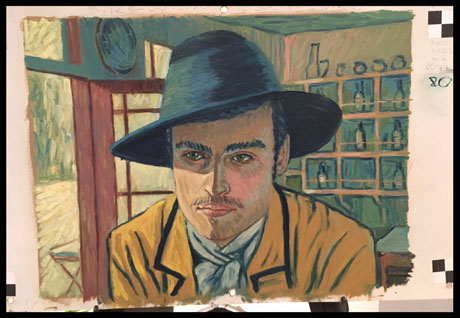
Leslie Combemale: For the readers of Animation Scoop, which is read by not only avid fans, but lots of people working in the animation industry, can you describe a little of how you designed PAWS?
Hugh Welchman: Basically the idea is to have the painting animators concentrate on painting and nothing else. Not to worry about lights, computers, and only focus on their own painting. So we bolted everything to the floor, put it out their sightline so they could just walk in, sit down, and start painting. We wanted to give them as much references as possible, so the way that we created reference was different for each shot, pretty much it was either CG animation reference material or it was live action combined with matte paintings, or it was blank space they had to fill in, based on Vincent’s paintings. sometimes they just had a blank for the sky and they had to animate the sky, so one end of the spectrum was the black and white footage which was pretty much live action realistic footage, although always made up of matte paintings and materials with the effects done, so we didn’t have to do fancy effects so that was more rotoscope. The other end of the spectrum was the painting transitions where there was just one or two frames and the animators had to paint between them but all of the Van Gogh material essentially they have a live action reference but then they have to paint it as a Van Gogh painting and they had to animate each brushstroke, frame by frame. The thicker the brushstrokes the more precisely they had to animate them. In the black and white it’s more like animating on glass, you could smooth the paint around the canvas, whereas with the very definite brushstrokes you actually had to move very deliberately frame by frame by frame, like stop-motion.
LC: Not like an in-betweener in 2D animation, though…
Dorota Kobiela: No, because with an in-betweener you’ve got a keyframe and another keyframe and you go from one to the other, knowing what’s coming. In this, the artist is doing all on one canvas and doing the keyframes and the art in-between.
HW: What we had for them was outlined reference, so that they could project it on the canvas and use it as a starting point, but it had none of the detail on there.
LC: So that’s more like an illustrator would work. So many different disciplines mixed together!
DK: Yes!
HW: In terms of our background, we’ve done CG animation, for example, our last film was purely pencil drawing animation, and then the other film she did before that was actually painting animation in 3D. My last film was stop-motion, and we’ve both done visual effects, so we used and combined all of that in Loving Vincent, and the thing with Van Gogh’s paintings is they’re all different and some of them abide by the laws of physics, and some of them don’t. Some of them he used a wide or a long lens, and some of them were more like a set, so we took them one by one, those we used. With the portraits it’s pretty straightforward, in terms of shooting the portraits and then they have to be basically repainted in the Van Gogh style, and the big challenge was obviously not to lose the performance of the actors. One of the things that you very often get with rotoscoping technique is that you lose the performance you get a layer between you and the actor. On thing we did was we paid a lot of attention to the eyes. That’s the thing that animation can often fail at in creating realistic performances, so hopefully we found a way past that.
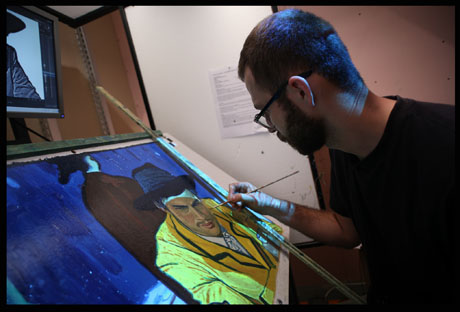
LC: How did you choose the artists you worked with?
DK: We received around 5000 applications. We first went through their portfolios, and based on that, we would invite artists to do a test, and this took around 3 days, which included painting in the Van Gogh style. Based on that test, they would go to another training.
HW: From 5000 applications, we invited 500 people to do a 3 day audition, of those we selected 113 for training, and pretty much all of those went on to do at least one shot in the film, with 125 painters, although a lot of those came on towards the end.
DK: The main crew was around 55 painters.
HW: A lot of the time we had around 20 painters, that was our core group.
LC: Dorota, you started out thinking you were going to paint the whole thing, did you paint any of the it?
DK: I painted one shot. The boy throwing the stone. It has a kind of shaky camera portrait. I picked it because I thought it was just the beginning for me, and I wanted a challenge and to do something I hadn’t done before, and to train on it. I thought after that one i’d do a lot more fun ones with color, and then it didn’t happen! I mean, it was 4 hours per frame, and I could only start in the evenings after going through a day of directing so that would be after 6pm and then i’d have to work till 2pm and then start over at 8am, so you know, I didn’t think it would be wise!
LC: You can’t really tell where art ends and animation begins. When I read someone’s review, who clearly doesn’t know much about the history of animation, they said what a labor of love and how extraordinarily work intensive it must have been. The whole span of the history of animation is filled with work intensive projects! Even just the example of the Queen in Snow White and the amount of airbrush and hand-inking on each cel…
DK: Exactly!
DK: I realize that we’ve been told we are crazy for how involved this project was, and so i’m glad you brought that up.
HW: Snow White is a great one to bring up, because there were far more cels used for that film than paintings or frames used for our film. Of course on Snow White they had drawings, and concept art, and cels, and on our film we had paintings that we change and destroy as we go along.
DK: Each painting is used for one shot, and there are around 900 shots in the movie, and each painting ends up as the last part of the shot. Sometimes the painting remained intact through the whole shot, sometimes we would scrape off the paint completely. Like with the moving camera shots… the first in the movie, you have Starry Night, then it moves to another image, and that shot was 10 seconds and painted over 7 months, put together with a number of painters who had different specialties. One was great with stars, another was best with tiny details of landscapes. It’s 12 frames per second, so it can take between 30 minutes for the easiest for up to 8 hours. Sometimes we would just scrape everything off and start again just to make sure and compare and get each image just right so they worked together.
LC: How is it photographed, from above?
DK: We had a camera mounted behind the painter, and they just would need to click. They could also see how they were doing and get a preview and see how it looked. They could export their image immediately, so I could look and check every frame, not in every single case, but for a long time we had an every frame approval system. They would have to check with the supervisor. And all the artists are getting paid per frame so waiting was an issue in terms of budget.
HW: The whole schedule and budget was based on timing, so we had to get fast approval. Also we had people in different parts of the world all working at the same time.
LC: How did financing come about for the film?
HW: It was very difficult. Every time we showed the film we had made to explain what the feature would look like, we would be asked to give examples of other films done in the same way. We said the fun thing about this is it’s something new, and people will like it because it hadn’t been done before. At that point they disappeared! We thought the hardest part would be to hand-paint the film or to train the artists who are used to being individuals and working in their own studios, and putting them all next to each other and that was the easy part. The hard part was the financing.
LC: Dorota, you are quite open about your own depression, that you’ve had it your whole life, can you talk about that and your connection to Van Gogh and what depression means to art.
DK: I guess I always made the connection, and even wrote my thesis about it at university, how art and depression effect each other. I thought it was very interesting so many writers, philosophers, and painters had it, and specifically Van Gogh. I have always been curious about the passion and vulnerability of artists makes them more sensitive or maybe it’s the other way around, the illness opens up a part of you that allows you to see things in a different way and offers a unique insight. I don’t know which comes first. I was very interested in Van Gogh’s letters. I strongly believe that he was very intense and just worked too much, he was painting two paintings a day and writing all night. Writing 820 letters.
HW: Surviving letters. Maybe way more existed. We don’t know.
LC: I am particularly interested in the fact that, as a woman in animation, you have chosen to do something that’s never been done before, that required an immense amount of work, and a great deal of passion, that you put your whole heart into, that is so personal.
HW: 75% of our painters were women. I have always tried to have women directors and heads of departments, but in Loving Vincent, it was a lovely surprise for us to have such a high percentage of women. In this case, it was purely because of skill and ability that it turned out that way.
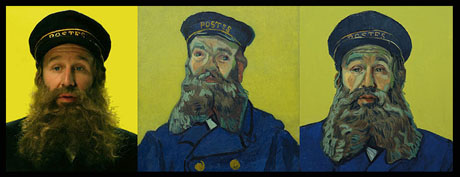
DK: This project required a lot of patience, and the women seemed to have that.
LC: Well, of course most of the ink and paint department at Disney was made up of women and in addition to skill, there was a great deal of patience required for that.
HW: I think the men found it to be too hard.
DK: For the women it was fun because they were challenging each other.
HW: They all wanted to be the best in the studio and became very competitive. In Poland our painters were divided equally between men and women, but in Greece, all our painters were women.
LC: Talk to me about how you are selling the paintings used to make the film. It’s a great way to get back some of the budget before you’ve even released the movie…and you’re also having an exhibit of the art?
HW: We have around a thousand paintings, from the film itself and also design paintings, because we spent six months doing design paintings before we started, re-imagining Vincent’s work. People were taking a full day or even a week to do those. One particular painting took a month! Of the thousand, a hundred and fifty we used for the financing of the film. Sometimes with the financiers and the actors, art was part of the deal. Each of the main actors got a painting of themselves and it was part of their contract. A hundred more we sold to the public along the way. We put them on our website and they would sell quite quickly..and we have an exhibition opening at the Noordbrabants Museum in Holland on October 13th which will have one hundred nineteen paintings of our favorite paintings from the film. That runs till the 28th of January.
We’d like to license that exhibition to America after it closes there. We are doing smaller exhibits elsewhere, including the Kroller-Muller, which has the second largest collection of Van Gogh collection in the world. In the film, we reimagined twelve paintings of theirs, so we are doing a collaboration with them and it will tour around Europe and Asia and then it will go into the Kroller-Muller Museum, which is great for us, next year, for about three months. All of the art will be sold at some point, all of it will go for sale, but much of it will be in exhibits first. Of course they won’t all be very expensive, there are some of them that are less. For example, when the film fades to black, we painted that, and now we have these canvases that are black and some are really nice because they have thick paint. They won’t be much, but a fan will want them, I hope!
All the money made from selling the art goes into recouping the film, because we have an investors pool and a talent pool for painters, we have a talent pool for actors, and for Dorota and I as directors. Still, we only really make any money if people go and see the film.
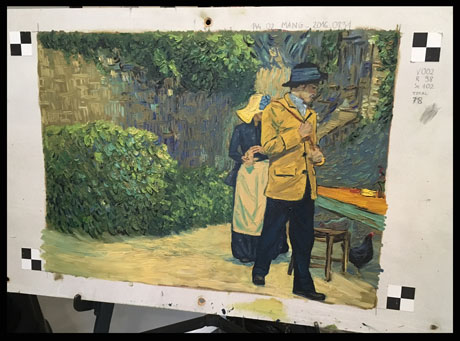
LC: You have lots of great premieres planned!
DK: Yes, we have a premiere with the National Gallery in London and the Musee D’Orsay in Paris. We are doing many of our national premieres in museums. With the National, it’s going to be broadcast in over 200 cinemas. We are doing an introduction that’s a walk through the National Gallery going to all the Van Gogh paintings and talking about them, which is about five or ten minutes, then we show the film, and then after the film we have a Q&A with all of the actors. For the Musee D’Orsay it is going to be in the big hall. The Van Gogh Museum in Amsterdam has a great space in their new building where we’ll have an event.
LC: So you got Clint Mansell as the scoring artist for the movie. What a coup, and he adds a lot to the film!
DK: He was involved in the film without even knowing about it. I would write the script listening to his scores, like The Fountain, Moon, and Black Swan. I wanted him, I built the story in my head with his music, so I really wanted him to be a part of it. To me this was important.
LC: He is also very outspoken about depression and is a strong advocate as an artist who has it. I would imagine he’d be all over this project.
DK: The truth is his music for me represents what I was looking for absolutely perfectly for the movie.
HW: He said no five times. He wasn’t taking on any new projects. We first approached him in 2012 and each time he said no. I told Dorota it was time we started discussing other people or adding more than just one person to her list. She said she really wanted him, so we asked again and he said he’d meet us in person to say he wouldn’t be doing the project. We met him in person.
DK: His agent called and said he would be in London the next day so we jumped on a plane so we could talk to him in person. We met with him and showed him a few shots we had from the film. Not even painted, but live action. Three hours later he invited us out to dinner, and then he said yes.
HW: There is an absolutely wonderful quote from him on the record that Dorota designed of the score. It says, “I’m not sure…..came into focus”

Hugh Welchman and Dorota Kobiela with their Annecy Award
LC: As a woman in animation how do you feel you informed the film?
DK: To be honest what I’m really proud of and what I’m always getting a hard time for is how sensitive I am. How much pain and hardship I have to go through to deal with certain things. So many people say “Come on! Deal with it! Stop being so emotional!” It’s a part of me as a director, being empathetic and sensitive. I just think this is a part of me that needs to be that way. I am not going to be one of those directors, or women in business for that matter, who think they need to act like what some men are like on-set, shouting and cursing at people, because it’s not my nature. I think that my emotional, sensitive nature is really good for communicating with people.
One time on the set, my male co-worker said something me, because he’d done lots of movies before. This was in Poland, and in Poland, there are so many men working in movies. There are no women apart from makeup and costume. The men dominate the production and are very aggressive. Very different than the UK. Anyway, he said, “You’re doing this all wrong. You have to shout at them, otherwise they won’t respect you.” I just don’t want to be respected by trying to be something I’m not. I am sensitive, but also my approach was to be really really prepared. That has always worked for me before and it worked on this.
LC: What is your next project?
DK: Well, this movie has been such a learning curve for us. But now we have some amazing painters and we want to do it again and continue to expand the style. We are a little bit obsessed with horror films, and we want to do a painted horror movie.
HW: The thing about animation horror films is they are either funny or scary, but we think in our style we can do both.
LC: Well, good luck with that, it sounds great. Good luck also with Loving Vincent. It’s a beautiful movie and I hope you have great success with it!
DK: Thank you so much.
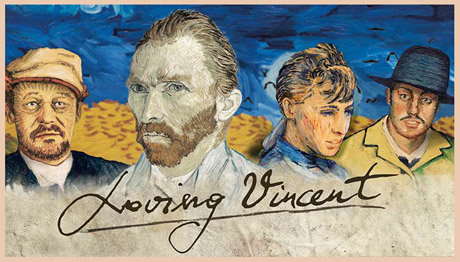
- CREATING COCO: An interview with Pixar’s Jason Katz, Story Supervisor - November 22, 2017
- OPEN LETTER: Animation Insiders Demand a Change from Sexism and Harassment in the Animation Industry - October 19, 2017
- The Glorious Labor of LOVING VINCENT: An Interview with filmmakers Dorota Kobiela and Hugh Welchman - September 28, 2017


 September 28th, 2017
September 28th, 2017  Leslie Combemale
Leslie Combemale  Posted in
Posted in  Tags:
Tags: 






